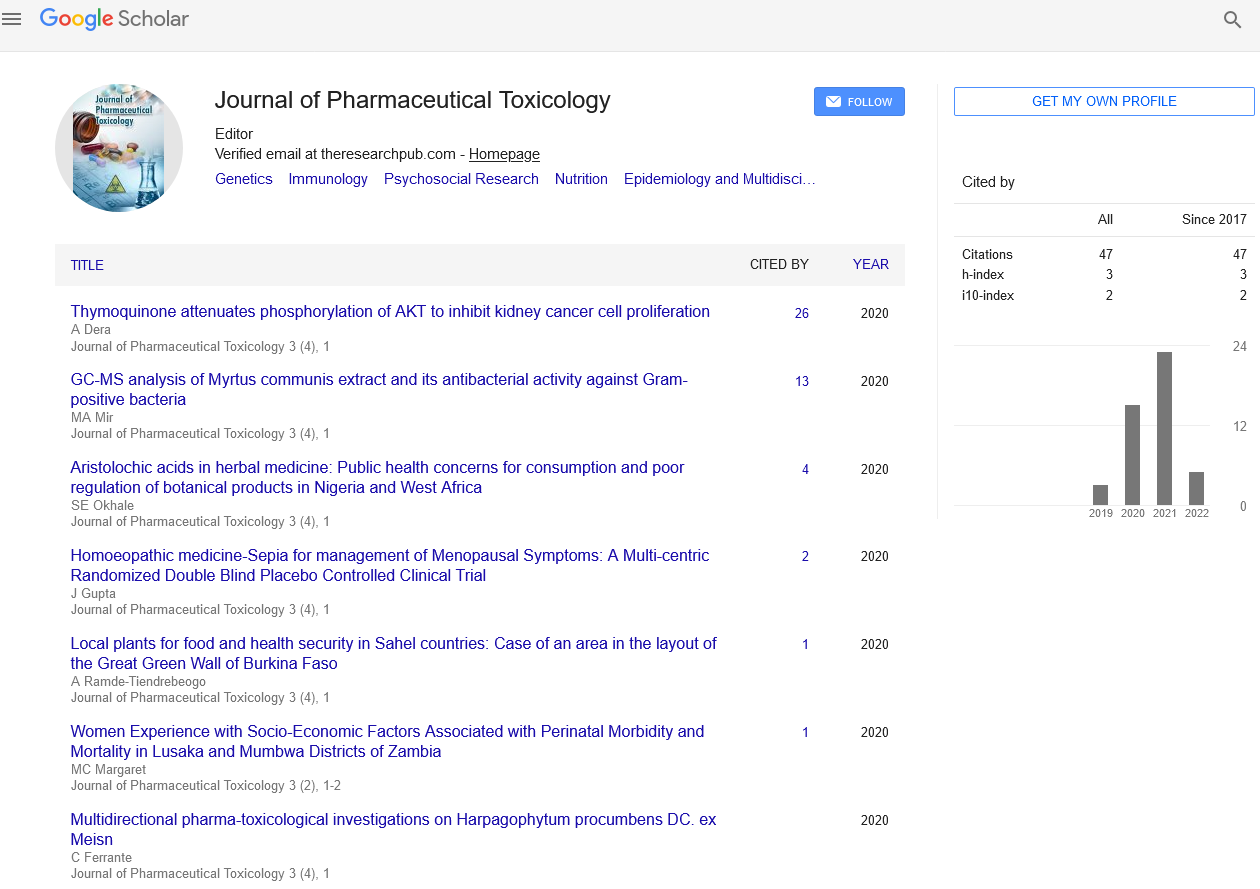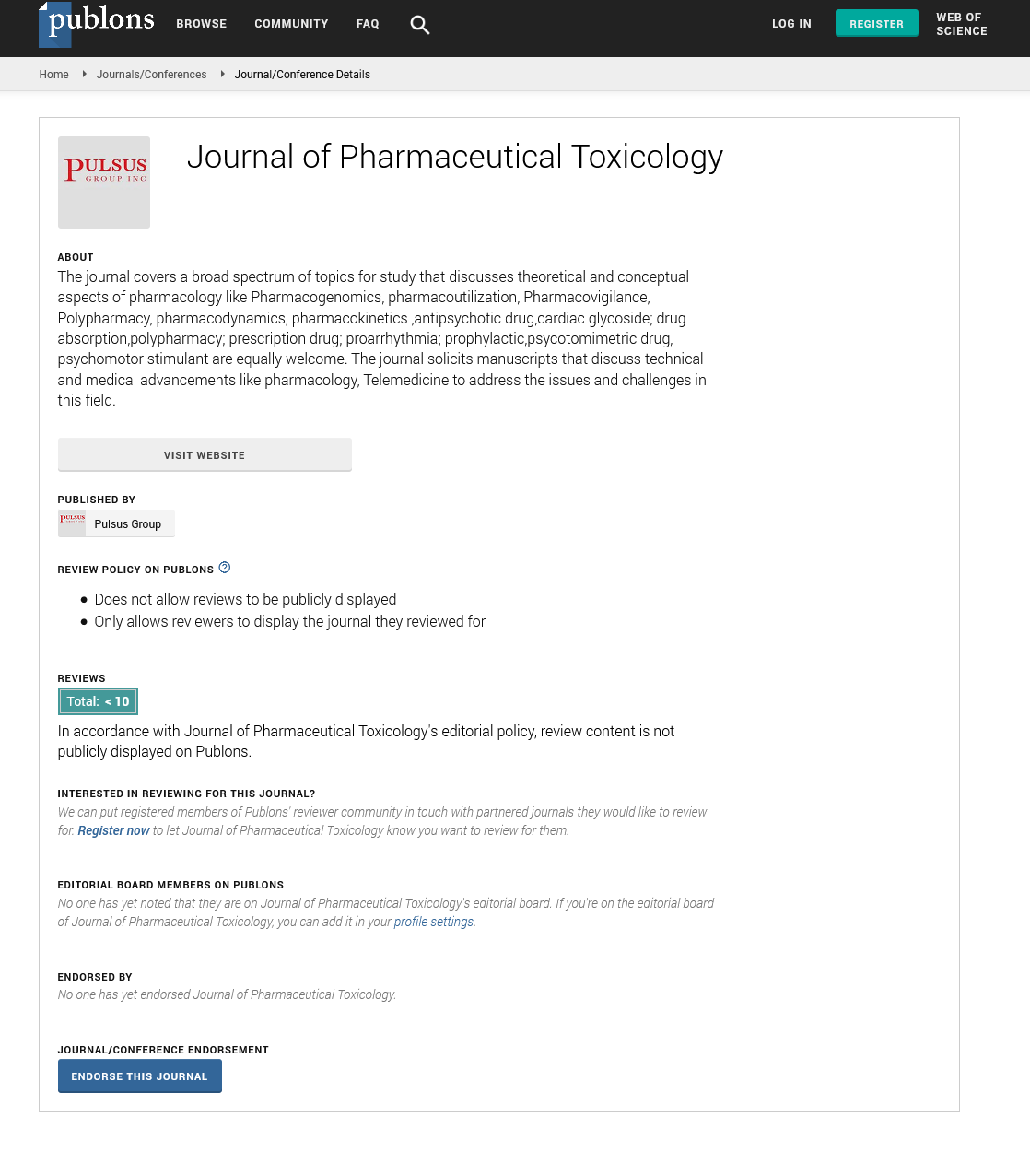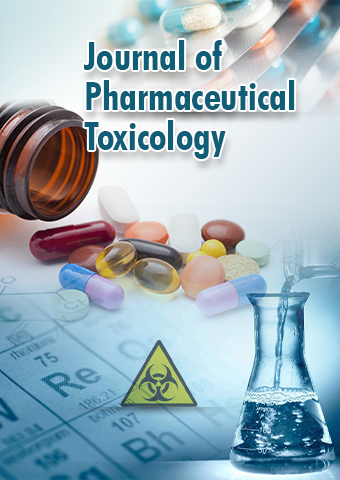Mini Review - Journal of Pharmaceutical Toxicology (2023) Volume 6, Issue 4
Pharmaceuticals have Contributed Greatly to Medical Advancements and Improved Public Health
Priya Gupta*
Rofel Shri G M Bilakhia College of Pharmacy, Gujarat Technological University, India
Rofel Shri G M Bilakhia College of Pharmacy, Gujarat Technological University, India
E-mail: priyasahu22@gmail.com
Received: 01-August-2023, Manuscript No. oajpt-23-108568; Editor assigned: 3- August -2023, PreQC No. oajpt-23-108568 (PQ); Reviewed: 17- August -2023, QC No. oajpt-23-108568; Revised: 22- August -2023, Manuscript No. oajpt-23-108568 (R); Published: 28- August -2023; DOI: 10.37532/ jpt.2023.6(4).105-108
Abstract
Pharmaceuticals, also known as drugs or medications, are chemical substances developed to diagnose, treat, cure, prevent, or mitigate diseases and medical conditions in humans and animals. These substances play a crucial role in modern medicine by improving health outcomes, relieving symptoms, and enhancing the overall quality of life for individuals affected by various illnesses. Pharmaceuticals can come in various forms, including tablets, capsules, injectable, creams, ointments, and more. They work by interacting with specific molecules or receptors in the body, altering biochemical pathways, and affecting physiological processes to achieve their intended therapeutic effects.
Keywords
Cardiovascular diseases • Cerebrovascular diseases • Drug discovery
Introduction
It is important to note that while pharmaceuticals provide significant benefits, they may also carry potential risks and side effects. Therefore, their usage should be carefully prescribed and monitored by healthcare professionals to ensure safe and effective treatment for patients. Additionally, advancements in pharmaceutical research and development continue to pave the way for innovative therapies and improved healthcare outcomes. Pharmaceuticals, often referred to as drugs or medications, are substances used for diagnosing, treating, preventing, or alleviating various medical conditions and diseases in humans and animals. They play a crucial role in modern medicine and healthcare, helping to improve and maintain the health and well-being of individuals worldwide.
Pharmaceuticals can be derived from various sources, including natural compounds, chemical synthesis, or biotechnological processes. They come in different forms, such as tablets, capsules, injections, creams, ointments, and liquids, and can be administered through various routes, including oral ingestion, injection, topical application, or inhalation. vaccines are a special type of pharmaceutical used to stimulate the immune system and create immunity to specific diseases. They often contain weakened or inactivated forms of the disease-causing microorganism or parts of it (like proteins), which trigger an immune response without causing the disease itself. This immune response helps the body remember how to fight off the real pathogen if encountered in the future, providing protection against the disease [1,2].
Material & Methods
These medications are used to prevent certain diseases or conditions from occurring in individuals at risk. For example, cholesterol-lowering drugs are used to prevent heart disease in individuals with high cholesterol levels, and antimalarial medications can be given to people living in or traveling to malaria-endemic regions. The pharmaceutical industry plays a vital role in the research, development, testing, manufacturing, and distribution of these drugs. Pharmaceutical companies invest significant resources in conducting clinical trials to ensure the safety and efficacy of their products before they are approved for use by regulatory authorities (e.g., the Food and Drug Administration in the United States or the European Medicines Agency in Europe).
It’s important to note that while pharmaceuticals have contributed greatly to medical advancements and improved public health, they also carry potential risks and side effects. Therefore, their use should be guided by healthcare professionals who can assess individual patient needs and monitor their response to the medications. Additionally, responsible use and adherence to prescribed dosages are essential to optimize the benefits of pharmaceutical treatments while minimizing potential risks.
Scientists research and identify potential new drugs through various methods, such as studying biological pathways, screening chemical libraries, or investigating natural sources like plants and microorganisms. Once a potential drug candidate is identified, it undergoes preclinical testing in laboratories and animal studies to assess its safety, efficacy, and potential side effects before testing on humans. If preclinical testing shows promising results, the drug candidate moves into clinical trials. These trials involve testing the drug on human volunteers to evaluate its safety, dosing, effectiveness, and potential adverse reactions. Clinical trials are conducted in several phases, with an increasing number of participants at each stage. After successful completion of clinical trials, pharmaceutical companies submit data to regulatory authorities (such as the Food and Drug Administration in the United States or the European Medicines Agency in Europe) for approval. The authorities review the data to ensure the drug’s safety and efficacy, and if satisfied, they grant approval for its use. Manufacturing and Marketing: Once a drug is approved, pharmaceutical companies start large-scale manufacturing and distribution. They market the drug to healthcare providers, who prescribe it to patients based on their medical needs.
Results
Pharmaceuticals, also known as drugs or medications, are substances that are used to diagnose, treat, prevent, or cure diseases and medical conditions in humans and animals. These substances play a crucial role in modern medicine, helping to alleviate symptoms, improve health outcomes, and enhance the overall quality of life for patients. Pharmaceuticals have significantly improved the management and treatment of numerous health conditions, leading to increased life expectancy and better overall health outcomes. However, they also carry potential risks and side effects, which is why they should be used under the guidance of healthcare professionals.
Pharmaceuticals, also known as drugs or medicines, are substances or compounds used to diagnose, treat, prevent, or cure diseases, medical conditions, or health issues in humans and animals. They play a critical role in healthcare by helping to alleviate symptoms, manage chronic conditions, and improve overall health and quality of life. Pharmaceuticals can be derived from various sources, including plants, animals, microorganisms, and synthetic chemical compounds. They undergo rigorous scientific research and development processes to ensure safety, efficacy, and regulatory approval before being made available to the public.
Here’s a brief overview of the stages involved in the pharmaceutical development process Scientists and researchers identify potential drug candidates by studying disease mechanisms, conducting experiments in the lab, and exploring natural sources for active compounds. In this stage, candidate drugs are tested on cell cultures and animal models to evaluate their safety and effectiveness. Data from preclinical studies are submitted to regulatory authorities for approval to proceed to clinical trials.
These trials involve testing the drug on human volunteers to assess its safety, efficacy, and dosage requirements. Clinical trials are conducted in several phases (Phase I to Phase IV), with an increasing number of participants to gather more extensive data. After successful completion of clinical trials, pharmaceutical companies submit data to health authorities for review and approval. Once approved, the drug can be marketed and prescribed by healthcare professionals. Pharmaceutical companies mass-produce the approved drugs following strict quality standards and regulations to ensure consistency and purity.
Discussion
Distribution and Use: The drugs are distributed to healthcare facilities, pharmacies, and other outlets where they can be prescribed and dispensed to patients. Patients take the prescribed drugs as directed by healthcare professionals. After a drug is available on the market, ongoing monitoring and surveillance occur to identify any previously unknown side effects or adverse reactions in real-world conditions. Pharmaceuticals can be categorized into different classes based on their mode of action, therapeutic uses, and chemical structures. Some common categories include antibiotics, antivirals, analgesics, antipyretics, antifungals, anti-inflammatory drugs, immunosuppressants, and more. It’s important to note that pharmaceuticals must be used responsibly and under the guidance of healthcare professionals to avoid potential risks and ensure their intended benefits [3-5].
Pharmaceuticals refer to drugs or medications that are used to diagnose, treat, prevent, or manage various diseases and medical conditions in humans and animals. These substances are typically developed through extensive research and testing before they are approved for use by regulatory authorities, such as the U.S. Food and Drug Administration (FDA) in the United States. The pharmaceutical industry plays a crucial role in healthcare, as it is responsible for discovering, developing, manufacturing, and distributing medications. The process of bringing a new pharmaceutical product to market involves several stages. Pharmaceuticals cover a wide range of products, including prescription medications, over-the-counter drugs, vaccines, biologics (large molecule drugs), and more. They play a crucial role in modern medicine by helping to alleviate symptoms, cure diseases, and improve the overall quality of life for many individuals.
Pharmaceuticals refer to drugs or medications that are used to diagnose, treat, prevent, or alleviate various medical conditions and diseases in humans and animals. These products are developed and manufactured by pharmaceutical companies through extensive research, testing, and regulatory approval processes. Pharmaceuticals play a crucial role in modern healthcare, contributing significantly to improving the quality of life and extending life expectancy.
It’s important to note that the development and use of pharmaceuticals are highly regulated to ensure patient safety and public health. Physicians play a critical role in prescribing the appropriate medications for their patients based on individual medical conditions and needs. Patients should always follow their healthcare provider’s instructions regarding the use of pharmaceuticals and report any unusual side effects or concerns promptly. Pharmaceuticals have revolutionized healthcare by providing effective treatments for a wide range of diseases, including infections, chronic conditions, cancers, and rare genetic disorders. However, they also come with potential side effects and risks, and their usage should always be guided by healthcare professionals to ensure proper diagnosis, treatment, and monitoring [6-8].
Pharmaceuticals, also known as drugs or medications, are chemical substances used to diagnose, treat, prevent, or manage diseases, medical conditions, and health disorders in humans and animals. These substances can be administered through various routes such as oral tablets, capsules, injections, topical creams, patches, and more. Pharmaceuticals play a crucial role in modern medicine and have significantly improved the quality of life for millions of people worldwide. Pharmaceuticals have revolutionized healthcare by providing effective treatments for numerous medical conditions, alleviating symptoms, and saving countless lives. However, their use should be under the guidance of healthcare professionals to ensure safe and appropriate usage. Pharmaceuticals have significantly advanced medical treatments and have played a vital role in improving the quality of life and extending the lifespan of individuals around the world. However, their usage must be carefully managed, and patients should always follow their healthcare provider’s instructions and guidelines when using these medications.
Prescription and Over-the-Counter (OTC) Drugs: Pharmaceuticals are available in two main categories – prescription drugs and over-thecounter (OTC) drugs. Prescription drugs require a physician’s prescription to obtain, as they are typically more potent, have more potential side effects, or are used to treat complex medical conditions. OTC drugs, on the other hand, can be purchased directly by consumers without a prescription for self-treatment of common ailments. Pharmaceuticals, also known as drugs or medicines, are substances used to prevent, diagnose, treat, or manage diseases, medical conditions, and various health issues in humans and animals. They play a crucial role in modern medicine and have significantly contributed to improving the quality of life and increasing life expectancy around the world [9,10].
Conclusion
Pharmaceuticals can be derived from various sources, including plants, animals, minerals, and synthesized chemical compounds. They undergo rigorous research, development, and testing processes to ensure their safety, efficacy, and quality before they are approved for use by regulatory authorities. The pharmaceutical industry encompasses a wide range of activities, including drug discovery, preclinical testing, clinical trials, manufacturing, marketing, distribution, and post-marketing surveillance. Pharmaceuticals, often referred to as drugs or medications, are substances used to diagnose, treat, cure, prevent, or alleviate the symptoms of various medical conditions or diseases in humans and animals. These substances play a crucial role in modern medicine and healthcare, helping to improve the quality of life and prolong the lifespan of individuals affected by illnesses.
References
- Hill–Taylor B, Walsh KA, Stewart S et al. Effectiveness of the STOPP/START (Screening Tool of Older Persons’ potentially inappropriate Prescriptions/Screening Tool to Alert doctors to the Right Treatment) criteria: Systematic review and meta–analysis of randomized controlled studies.J Clin Pharm Ther.41, 158–169 (2016).
- Tommelein E, Mehuys E, Petrovic M et al. Potentially inappropriate prescribing in community–dwelling older people across Europe: A systematic literature review.Eur J Clin Pharmacol.71, 1415–1427.
- Sadozai L, Sable S, Le E Roux et al. International consensus validation of the POPI tool (Pediatrics: Omission of Prescriptions and Inappropriate prescriptions) to identify inappropriate prescribing in pediatrics.PLoS ONE.15, 47–72 (2018).
- Barry E, Moriarty F, Boland F et al. The PIPc Study–application of indicators of potentially inappropriate prescribing in children (PIPc) to a national prescribing database in Ireland: A cross–sectional prevalence study.BMJ Open.8, 69–556 (2019).
- Al–Badri A. Almuqbali J, Al–Rahbi K et al. A Study of the Paediatric Prescriptions at the Tertiary Care Hospital in Oman.J Pharmaceut Res.5, 17–56 (2020)
- Al–Maqbali, Haridass S, Hassali M et al. Analysis of Pediatric Outpatient Prescriptions in a Polyclinic of Oman. Glob J Med Res.19, 2249–4618 (2019).
- Cullinan S, O’Mahony D, Fleming A et al. A meta–synthesis of potentially inappropriate prescribing in older patients.Drugs Aging.31, 631–638(2014).
- Liew TM, Lee CS, Goh Shawn KL et al. Potentially Inappropriate Prescribing Among Older Persons: A Meta–Analysis of Observational Studies.Ann Fam Med.17, 257–266(2019).
- Crowe B, Hailey D. Cardiac picture archiving and communication systems and telecardiology – technologies awaiting adoption. J Telemed Telecare.8, 3–11(2002).
- Bouchier IA. Postmortem study of the frequency of gallstones in patients with cirrhosis of the liver. Gut. 10, 705-710.
Indexed at, Google Scholar, Crossref
Indexed at, Google Scholar, Crossref


